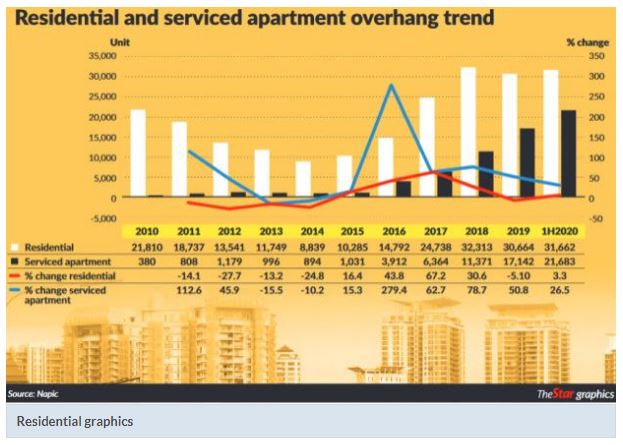Malaysia: Loopholes that lead to property overhang
PETALING JAYA: Flaws at the planning approval process and a failure to consider market conditions have led to over-building, and thus to the overhang situation in the country. Although land is a state matter and town planning is a powerful tool, state local authorities have failed to use it and developers “take advantage of” these loopholes.
These are among some of the structural failures identified in a book published by the Royal Institution of Surveyors Malaysia (RISM), titled “Investigating the Property Overhang Situation: Policy Analyses”.
An overhang refers to completed units certified fit for occupation but remain unsold more than nine months after launch date. The study, spanning 2010 to 2019, focuses on Johor and Selangor’s housing and serviced apartments. Melaka, with the least overhang is used as a benchmark for good housing supply governance.
On a national basis, residential overhang on June 30 stood at 31,662 units, a 3.25% rise in volume versus end 2019, valued at RM20.03bil, and predominantly stratified housing. Serviced apartment overhang rose by 26.49% in volume to 21,683 units (2019: 17,142) from six months ago, valued at RM18.64bil, a National Property Information Centre (Napic) report showed.
The red flag is that the supply of new residential and serviced apartments is continuous, in spite of a prolonged slump, with higher price units still dominating the supply scene, although this category has the most severe overhang, Valuation and Property Services (JPPH) former director general Datuk Rahah Ismail wrote.
She said that although an overhang is a feature of the property market, there is a social cost to the yearly ballooning figure, besides an economic and financial one.
Rahah, who has 37 years experience in JPPH and retired in 2017, said the government looks at the total aggregated figure and is worried, but developers view it “project-by- project and location-by- location” and are not worried.
Instead, “as part of their business strategy, ” they use the rising overhang to get government support to market unsold stock by seeking stamp duty waivers for buyers, which results in the government losing much-needed revenue even during tough times like now.
The government must intervene constructively instead of coming up with policies which are “counter-productive.” A copy of the book was presented to Housing and Local Government Minister Zuraida Kamaruddin. It came off the press last month.
The publisher, RISM president Datuk Thiruselvam Arumugam, said the overhang was a long outstanding issue first highlighted after the 1997 Asian Financial Crisis.
The magnitude is three times more in volume and 11 times more in value than the first overhang data captured in 2004. The study period of this collaborative research is between 2010 and 2019.
After the 1997 crisis, developers minimised government concerns, saying that property cycles exist and when the market picks up, they would be able to sell their units.
“The government was worried, but they were not, ” Rahah said, adding that developers have a powerful lobby at public and private levels.
Besides Rahah, other writers include Napic director Aina Edayu Ahmad, Universiti Malaya’s Built Environment Faculty deputy dean Yasmin Mohd Adnan, AB Property Solutions CEO Datuk Azimudin Bahari, who previously held positions involved in strata titles and land management issues at Land and Mines Department, and National Institute of Valuation (Inspen) head Siti Rosemawar Mohd Sahi.
The starting point of the quandary is that “existing supply situation is not taken into consideration” and independent market and feasibility studies are not a criteria when developers seek building approvals from state local authorities.
Emphasis instead is put on compliance with no thought given to existing market conditions, nor what has been approved in the same or neighbouring municipalities, the writers say.
“Planning authorities take the stand (that) developers have the right to enjoy and develop their land as long as they comply with the local plan, the zoning, the density and other requirements set by technical departments, ” the research concluded.
Secondly, although each state has its own local plans, these plans “neglect the element of effective demand” in forecasting. A local plan is a projection of future needs and serves as a guide for the direction of development but “developers often justify building more houses” for various reasons, and the authorities allow them to do so, resulting in “modification of local plan”.
A third loophole is planning approvals, which, once granted, “never lapses”. Because the authorities do not know when construction will commence, no consideration is given to market conditions when giving approval, ” research showed.
“Developers wait for the right timing to begin their launch” which may be years later.
They start building “devoid of (independent) market advice”, the fourth flaw in the system. Although Napic has the data, it is not part of the technical committee granting building approvals and technical departments do not have current data.
The state “merely endorses recommendations” with no directive to address oversupply; ff there actions, they are “reactive”.
The collaborative research recommends some of the following changes:
> Greater emphasis be given to market conditions and the overhang
> Napic to be included in planning approval process
> Independent market and feasibility studies a must when seeking building approval, and not valid after six months
> A RM1mil deposit from developers to ensure construction within six months after start-order is approved, or face forfeiture.
Source: https://www.thestar.com.my/business/business-news/2020/10/30/loopholes-that-lead-to-property-overhang


 Thailand
Thailand




